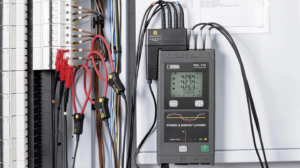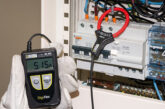
Julian Grant, General Manager at Chauvin Arnoux UK, breaks down how the right power and energy logger can help to identify issues with maximum demand and harmonics at domestic and commercial installations.
Many modern homes are experiencing shifts in the types of electrical equipment being installed or requested, particularly with the introduction of high-power devices. Notable additions include heat pumps and EV charging stations, which contribute to an increase in overall electrical demand.
Domestic air source heat pumps can typically consume from 3 kW to 7 kW (13 A to 30 A) of electricity, dependent on the size of the unit, the temperature settings, the weather conditions, and the thermal insulation efficiency of the property.
Add a single-phase home EV charger, which could require another 7 kW (30 A), and bearing in mind all the other potential “electricity hungry” appliances in the installation, such as showers, water heaters, hot tubs, ovens, etc. and it’s easy to see the issue.
Little room for additional loads
In the best of cases the installation will already be served by a 100 A main fuse, however, it’s more likely that an 80 A or even 60 A fuse may be present. Either way, conventional maximum demand and diversity calculations, as described in the On-Site Guide, are increasingly revealing situations where a large part of the capacity may already be already taken up, leaving insufficient headroom for any desired or required additional loads.
In the 60 A/80 A main fuse scenario, a larger fuse could be requested, but the immediate granting of these may not necessarily be straightforward, or cost-free, depending on the local supply capacity and the nature and rating of the equipment and cable feeding the property.
So where does that leave the property owner and the electrical installer?
Well, there is potentially another way to look at the maximum demand of the installation, referred to by the Energy Network Association (ENA) in its guidance on connecting electric vehicles and heat pumps to the network, and that is to measure and monitor it.
In this scenario electricity demand data is measured and recorded, ideally over a two-week period at ten-minute intervals, before being analysed to arrive at an accurate maximum demand figure.
This “evidenced” load assessment will often reveal spare capacity, where diversity calculations did not, or at the least could indicate the times when spare capacity may be available.
This could, for example, enable the fitting of a smart EV charger that incorporates load monitoring to ensure maximum demand isn’t exceeded, and with the knowledge that it will actually be able to charge an electric vehicle for significant periods of time without being throttled down.
Getting a more detailed picture
A simple and non-intrusive way to monitor and measure energy use over time would be to temporarily install a modern portable energy logger (PEL), such as the PEL113 from Chauvin Arnoux.
PELs can be installed quickly and non-intrusively at the distribution board, in many cases without even having to turn off the supply. They will log electrical energy data over any time period you choose – hours, days or weeks – so that you can get a detailed picture of the electricity usage.
But that’s not all a PEL will tell you. Another important concern with EV charge points, for example, are harmonics. The supply system is AC, but to charge a vehicle battery you need a DC supply, so at some point in the charging system – either in the charger itself or in the vehicle – there is going to be a rectifier.
Rectifiers are inherently non-linear loads that generate harmonics, and if the harmonics in the installation are too great all sorts of strange anomalies, and a general reduction in the electrical efficiency of the installation, may occur.
A PEL will give you accurate information about any harmonics that already exist in the installation, perhaps as a result of LED lighting, IT equipment, or the plethora of other non-linear loads that exist today, once again logging this information over a period of time.
When it comes to retrieving information from a PEL (aside from the obvious process of going to the installation and downloading the contents from the unit’s internal memory via a USB connection) the latest generation PEL113 from Chauvin Arnoux offers additional communication options such as Ethernet RJ45 or Wi-Fi.
Get more technical advice and support from Chauvin Arnoux here
Find more industry feature articles here









